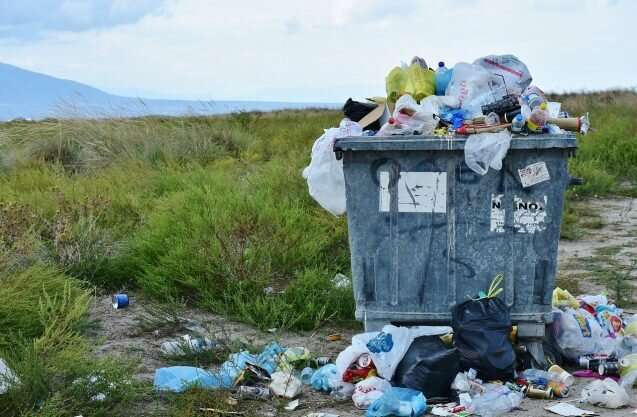Reduce. Reuse. And then, when all else fails, recycle

A municipal waste worker turns away another shipment of recycled materials littered with greasy pizza boxes and broken glass, sentencing this waste to slow death in a landfill without a second thought.
As he does so, a woman speaks up in my presentation to visitors at Olympic National Park in upstate Washington, pleased with her efforts to protect the environment for future generations.
Full of pride, she describes her active role in the fight against climate change. She tells me she is doing her part. She recycles.
She is far from unique in this perspective. I have had countless conversations with self-proclaimed environmentalists who believe recycling is adequate action.
A 2016 study from the Pew Research Center showed recycling as a primary method of helping the environment through every day actions, with 63 percent of adults in the U.S. saying they have recycling bins at home, more than any other action presented in the study.
Modern recycling has become a part of life, but what happens when those plastic containers leave our curb?
The obvious answer is that it makes its way to a recycling facility, but this is too often not the case.
China, which had previously handled more than half of American recycling, closed its doors to our waste in 2017. Still, the U.S. continues to ship over one million tons of plastic waste overseas, according to an investigation published by The Guardian in 2019.
Moreover, between 20 and 70 percent of this plastic is discarded because it is contaminated or otherwise unusable, condemning this waste to landfills where it will remain long after you, or I, or any of our children are gone. The wide range in the estimates of how many recyclables actually end up in landfills is but one indicator of how little we really understand about the true environmental impact of commercial recycling.
Likely the woman from my presentation didn't know this, or maybe she didn't care.
Certainly, our society has a waste problem, as seen in overflowing landfills and islands of trash in our oceans. In its current capacity, recycling is not an adequate solution to this problem. Refocusing on waste prevention and reuse could more effectively prevent these piles of trash from continuing to grow, but how can we foster this change?
By the time the slogan, "Reduce, Reuse, Recycle," was popularized in the 1970s, our consumerist economy was in full swing. Manufacturers couldn't afford to have people buying less by reducing purchases and reusing products, and people weren't interested in reducing their consumption. While recycling should have been the last resort, people began to consider it the singular solution to our waste problem. The image of three green arrows became a symbol for commercial recycling, and ideas of reducing and reusing were quickly forgotten.
Reduction and reuse are not modern notions. Until the late 19th century, families used old fabrics for new clothes or blankets and repaired their own furniture, and whatever they couldn't use was reclaimed by merchants who could. Historian Susan Strasser has described how this form of recycling was a part of life long before commercial recycling was even comprehensible, and this approach resulted in the generation of very little waste in general.
During the advent of the Industrial Revolution, waste became a notable problem, and recycling became important in a new way. Where earlier forms of recycling were born in response to limited materials and thin wallets, modern recycling was a solution to unmanageable amounts of waste.
If the 63 percent of American adults who recycle at home practiced 19th-century recycling instead, emphasizing reduction and reuse, the impact on industry would be shocking. Repurposing and repairing wearing clothing, finding reusable alternatives to household products and packaging, and reducing consumption of disposable items where we can, could change the way our society thinks about waste.
There are barriers to these practices, like a lack of accessibility and affordability stemming from high prices of sustainable products or product repairs, especially in comparison to the affordable nature of cheap, disposable products. With increased demand and improved regulation of the lifespan of products from production to disposal, there is hope for this to improve in time.
Regulatory frameworks could include subsidies for reusable or compostable single-use materials, tax penalties for single use plastic production, other incentives for durable products, or plenty more creative solutions.
Our environmental problems run much deeper than waste, with greenhouse gas emissions creating a dangerously unstable climate. This being said, with reduced energy use in manufacturing and shipping, reduction and reuse can go further in alleviating these problems than recycling alone could.
I'm not blaming the virtue-signaling woman who spoke up in my program, or telling you to stop recycling. In fact, I commend her efforts, and hope that you recycle better, avoiding contaminated materials in your own curbside bin.
Emphasizing reduction and reuse can do so much more to manage waste, though. Pushing for governmental regulation to pressure major waste-producing industries can go even further. Successful plastic bag bans around the world are a great example of where to start. Next, we must look to other single-use products and waste sources to continue this momentum.
Provided by Earth Institute at Columbia University
This story is republished courtesy of Earth Institute, Columbia University http://blogs.ei.columbia.edu.




















